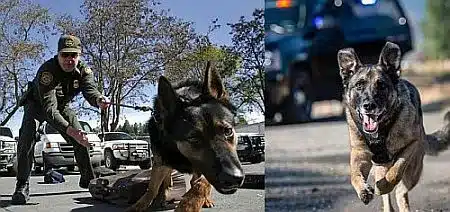Police Dog Attack
In Circleville, Ohio, a routine drive turned into an unexpected ordeal for Jadarrius Rose when he was behind the wheel of his 18-wheeler. The trouble began with a minor issue – a missing mudflap that drew the attention of the highway patrol.
A surprising turn of events followed as Rose faced a police dog whose powerful jaws latched onto him despite his attempts to surrender.
On July 4th, as he stood by the side of the highway with his hands raised, at least six law enforcement officers encircled him at a certain distance. The highway patrol video captures one officer emphatically instructing the K-9 handler, ”
Hold back the dog; do not release it.
However, the video shows a Belgian Malinois breaking free or being released. Initially, the canine appears disoriented, dashing past Rose towards officers at the truck’s distant end. It then doubles back and heads toward Rose, who is 23 years old.
At that point, the truck driver is down on his knees with his hands still raised while an officer urgently yells,
“Remove the dog from him!”
On that day, Rose became another addition to the extensive list of Black Americans who have faced police dog attacks, a historical pattern thoroughly chronicled by journalists, scholars, and filmmakers.
Over the recent years, there have been ongoing investigations into such incidents. For many, these scenes evoke memories of the Civil Rights Movement, when authorities frequently unleashed dogs and fire hoses on peaceful Black demonstrators advocating for equal rights.
City Police Department
The Associated Press documented an iconic moment from this history in a photograph taken in Birmingham, Alabama, in the spring of 1963. The image portrays two police officers releasing K-9s on 15-year-old Walter Gadsden. In the photo, one of the dogs charges directly at the teenager’s abdomen while the other tugs at its leash with visible agitation.
The United States has recently witnessed a surge in attention-grabbing incidents involving contentious police K-9 attacks over the past five years.
The Associated Press, during their 2018 investigation, examined records revealing that the Ohio State Highway Patrol deployed drug-sniffing dogs in approximately 28% of their encounters with Black motorists between 2013 and 2017.
This statistic is notable, considering that the Black population constitutes merely around 11.5% of those eligible to hold a driver’s permit or license in the state.
In 2020, the Salt Lake City police department halted its dog apprehension program after a Black man suffered a dog bite, and an audit discovered 27 similar dog bite incidents over the previous two years.
Police Department
In 2021, the FBI initiated an inquiry into the police department in Woodson Terrace, Missouri, when cellphone footage displayed three officers permitting a dog to bite a Black man repeatedly. Also, in 2020, a Black man in Lafayette, Indiana, was left in a medically induced coma due to police dogs mauling him during his arrest in a battery case.
Reamore Judge fines Trump $5,000 post maligning court staffer campaign website on found
City Police Department
Circleville, approximately 25 miles (40 km) south of Columbus, Ohio, resembles numerous rural communities nationwide. The town’s center is brimming with eateries, legal firms, and a bakery. Adorning the lampposts along Main Street are flags paying tribute to the courageous servicemen and women who have given their lives.
While the town’s picturesque image may resonate with some of its 14,000 residents, the Reverend Derrick Holmes, a respected figure at the Second Baptist Church, highlights that Black and white residents often perceive their lives differently.
Holmes remarked, “Not everyone shares the same experience, even though they reside in the same town. I believe these divisions are rooted in the harsh realities of bigotry and racism.”
Following the release of the video depicting Rose’s arrest, the congregation at the church held services, where Holmes noted a mixture of horror, anger, and frustration among its members. There was a prevailing sense of déjà vu, with many feeling,
“Here we go again.”
It’s worth noting that this incident is not Circleville’s first encounter with uncomfortable questions about the training and use of police dogs. Nearly two decades ago, a founding member of the K-9 unit took legal action against the department after being terminated for insubordination. Officer David Haynes publicly opposed reducing the training hours for dogs and handlers from 500 hours annually to 172 hours, as detailed in court documents.
Back in 2003, Haynes issued a prescient warning in a memo, stating that terms like “deliberate indifference,” “negligence,” and “failure to train” might come back to haunt the department.
Currently, Circleville’s K-9s receive 16 hours of training each month, totaling 192 hours annually, as per the department’s records. Police Chief Shawn Baer did not respond to several attempts to seek comment.
The utilization of dogs for population control traces back to European settlers in the Americas, where they were employed against Indigenous communities.
South Carolina
In Southern U.S. states, they were introduced to capture and, at times, kill escaped enslaved Black individuals. Madalyn Wasilczuk, a professor at the University of South Carolina and the author of a law journal article titled “The Racialized Violence of Police Canine Force,” noted that comprehensive data on K-9 police attacks is limited. However, she points out that these animals are frequently used in nonviolent situations, and their presence can lead to severe injuries.
Wasilczuk Explained,
“When law enforcement discusses apprehension, they often refer to ‘bite and hold,’ which may sound clinical. However, when you watch a video of such an incident, you see the dog treating the person much like a chew toy, gripping firmly, shaking its head vigorously, with teeth sunk as deeply as possible into the body part.”

